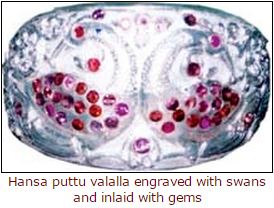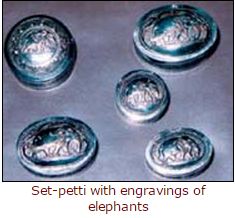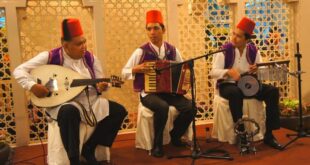The jewellers of Nilavala
by ASIFF HUSSEIN
There could hardly be imagined a more beautiful sight than a Kandyan lady wearing her embroidered bodice covered with a sari of old Indian brocade, bare-footed, and covered with delicate tinkling chains and pendants, rings and bracelets, of which profusion one feels that nothing could be spared. – Ananda Coomaraswamy
 Nestled in the Kandyan hills, the little village of Nilavala has a tradition of jewellery making going back to centuries. The charming pieces of jewellery turned out by the generations of artisans here have long captured the fancy of King and commoner alike – and not surprisingly.
Nestled in the Kandyan hills, the little village of Nilavala has a tradition of jewellery making going back to centuries. The charming pieces of jewellery turned out by the generations of artisans here have long captured the fancy of King and commoner alike – and not surprisingly.
Traditional Kandyan jewellery like Agasti Mala, Hansa Puttu valalu, Lunu Mal karabu, ridi havadi and padagam are turned out here using age old methods and designs in a variety likely to captivate the heart of any Kandyan damsel.
Origin
The legendary origins of Nilavala are as colourful as the jewellery it produces. Nilavala, according to an elderly native of the village, Ratnavalli Navaratna Abharana Gedara Vijeratna was founded by a Brahman named Nila Narayana.
 The legend has it that four Brahmans, namely, Nila Narayana, Parama Narayana, Deva Narayana and Tinna Narayana arrived in the country during the time of Arahat Mahinda and decided to settle down here. Deva Narayana settled in Aldeniya while Parama Narayana settled in Madawala and Tinna Narayana settled in Udispattuva. Nila Narayana having settled in Nilavala gave rise to a community of artisans who became famous in the days of the Kandyan kings and all the forty or so artisan families of the village trace their ancestry to him.
The legend has it that four Brahmans, namely, Nila Narayana, Parama Narayana, Deva Narayana and Tinna Narayana arrived in the country during the time of Arahat Mahinda and decided to settle down here. Deva Narayana settled in Aldeniya while Parama Narayana settled in Madawala and Tinna Narayana settled in Udispattuva. Nila Narayana having settled in Nilavala gave rise to a community of artisans who became famous in the days of the Kandyan kings and all the forty or so artisan families of the village trace their ancestry to him.
Vijeratna’s family gained esteem when one of his ancestors was conferred a high-sounding titular name and given lands by a Kandyan king of yore. The story goes that the king who was travelling from Kandy to Hanguranketa on horseback had sought shelter in the house of the jeweller after his horse had broken its legs and could take him no further.
The king, having made his way to the house amidst dense forest was given a mat and told to sleep outside by the woman of the house as her man was away at the time.
The jeweller having arrived, recognised the sleeping figure to be that of the king and quickly made a gem-set ring which he surreptitiously placed on the person of his king. The following morning the king found his way to the palace and ordered that the jeweller be brought to court.
 Being much pleased with him, he conferred on him the grandiose title of Aldeniye Rajakaruna Devasurendra Manuvira Vikrama Sri Karjuna Radala Bhuvanekabahu Raja Abhisheka Vichitra Chitra Nirmita Sakala Silpacharya Sri Dhantadhatu Makaraddaja Pata Savuttari Mudali Davunda Ratnavalli Navaratna Abharana Gedara Abharana Muhandiram, of which his descendants retained only the name of Ratnavalli Navaratna Abharana Gedara as their vasagama or ge-name.
Being much pleased with him, he conferred on him the grandiose title of Aldeniye Rajakaruna Devasurendra Manuvira Vikrama Sri Karjuna Radala Bhuvanekabahu Raja Abhisheka Vichitra Chitra Nirmita Sakala Silpacharya Sri Dhantadhatu Makaraddaja Pata Savuttari Mudali Davunda Ratnavalli Navaratna Abharana Gedara Abharana Muhandiram, of which his descendants retained only the name of Ratnavalli Navaratna Abharana Gedara as their vasagama or ge-name.
The jeweller was also given 999 acres of land by the king which was subsequently taken over by the government some time ago.
Rare ornament
Vijeratna turns out some wonderful pieces of silver jewellery like the havadi or waist chain worn with the osariya or Kandyan sari, koral male necklace worn by aristocratic Kandyan dames comprising spherical silver filigree beads known as kasa gedi, pattan gedi and coral, agasti male made of red agasti stone and silver filigree chains, an ornate inch-wide silver bangle known as tuna bandi sari valalla and a similar silver bangle engraved with the forms of two swans and set with gems known as hansa puttu valalla. Vijeratna also manufactures a very rare Kandyan ornament known as the botupetta, a disc-like silver pendent set with a jewel in the middle and suspended from the neck with a black thread.
This ornament we were told was worn by Kandyan women over a century ago at the time of their marriage, a practice known as botupetta-bandinava. Besides silver jewellery, Vijeratna also manufactures gold jewellery and brass items and supplies to Laksala and other handicraft shops. He also has several certificates to his credit. One of his more notable creations is a miniature giraya and heppuva made of silver, no doubt the smallest in the world. Vijeratna learnt his trade from his father who in turn learnt it from his father. He has two sons Ariyaratna and Mahinda who are continuing the good work and would hopefully pass it on to posterity.
Silver flowers
 Another skilled native of the village, Kosibune Abharana Gedara Abharanappu is a jeweller of no mean repute and specialises in an intricate form of jewellery involving little silver flowers known as lunu mal being formed into ornaments such as necklaces, bangles and ear-rings. The necklaces so made are known as lunu-mal mala while the bangles are known as lunu-mal valalu and ear-rings lunu-mal karabu. Abharanappu also manufactures other kinds of traditional silver jewellery such as pol-mal mala (coconut-flower garland) and Siri-bo mala (betel-flower garland). The items for sale include silver jewellery such as bangles, necklaces, anklets and waist-chains as well as disc-shaped copper engravings of stylized sun and moon known as ira-handa, ornate silver-plated little boxes known as set-petti and miniature containers for storing medicines known as pil-petti.
Another skilled native of the village, Kosibune Abharana Gedara Abharanappu is a jeweller of no mean repute and specialises in an intricate form of jewellery involving little silver flowers known as lunu mal being formed into ornaments such as necklaces, bangles and ear-rings. The necklaces so made are known as lunu-mal mala while the bangles are known as lunu-mal valalu and ear-rings lunu-mal karabu. Abharanappu also manufactures other kinds of traditional silver jewellery such as pol-mal mala (coconut-flower garland) and Siri-bo mala (betel-flower garland). The items for sale include silver jewellery such as bangles, necklaces, anklets and waist-chains as well as disc-shaped copper engravings of stylized sun and moon known as ira-handa, ornate silver-plated little boxes known as set-petti and miniature containers for storing medicines known as pil-petti.
 Asiff Hussein – Asiff Hussein Web Site
Asiff Hussein – Asiff Hussein Web Site




